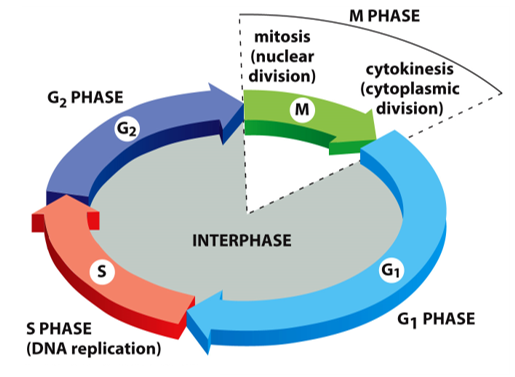G2 phase: Difference between revisions
No edit summary |
Cleaned up the text. |
||
| (2 intermediate revisions by one other user not shown) | |||
| Line 1: | Line 1: | ||
The [[Eukaryotic cell|eukaryotic cell cycle]] occurs in 4 phases: the [[Mitosis|M phase]], the G1 phase, the [[ | [[Image:Cell Cycle phases.png|thumb|left]] The [[Eukaryotic cell|eukaryotic cell cycle]] occurs in 4 phases: the [[Mitosis|M phase]], the G1 phase, the [[S phase|S phase and]] the G2 phase. | ||
The G1 and G2 phases are referred to as 'gap' phases - their jobs are to monitor the cell between | The G1 and G2 phases are referred to as 'gap' phases - their jobs are to monitor the cell between its major phases and ensure that it is fit to move into the next respective phase; either the S phase (DNA replication) or the M phase (mitosis), respectively. They are often known as 'checkpoints' as it is during these periods that both the cell's internal and external environments are checked and monitored<ref>Delete Alberts, Bray, Hopkin, Johnson, Lewis, Raff, Roberts, Walter (2014) Essential Cell Biology, 4th edn., New York: Garland Science, Taylor &amp;amp;amp;amp;amp;amp;amp; Francis Group.</ref>. This monitoring involves ensuring the cell is suitable to progress through the [[The cell cycle|cell cycle]]<font>or whether it needs a little more time to prepare. </font> | ||
The G2 phase occurs between the S phase and the M phase. It is a crucial stage as it ensures the S phase has been carried out correctly and prepares the cell for mitosis. This preparation involves making sure the [[DNA|DNA]] is intact and checking [[Chromosome|chromosome]] duplication has | The G2 phase occurs between the S phase and the M phase. It is a crucial stage as it ensures the S phase has been carried out correctly and prepares the cell for mitosis. This preparation involves making sure the [[DNA|DNA]] is intact and checking [[Chromosome|chromosome]] duplication has occurred, without which the M phase cannot proceed. Any found errors (such as damaged DNA) can then be corrected and repaired by the cell during the G2 phase. | ||
<br> | <br> | ||
=== References === | |||
=== References | |||
<references /> | <references /> | ||
Latest revision as of 20:03, 4 December 2017

The eukaryotic cell cycle occurs in 4 phases: the M phase, the G1 phase, the S phase and the G2 phase.
The G1 and G2 phases are referred to as 'gap' phases - their jobs are to monitor the cell between its major phases and ensure that it is fit to move into the next respective phase; either the S phase (DNA replication) or the M phase (mitosis), respectively. They are often known as 'checkpoints' as it is during these periods that both the cell's internal and external environments are checked and monitored[1]. This monitoring involves ensuring the cell is suitable to progress through the cell cycleor whether it needs a little more time to prepare.
The G2 phase occurs between the S phase and the M phase. It is a crucial stage as it ensures the S phase has been carried out correctly and prepares the cell for mitosis. This preparation involves making sure the DNA is intact and checking chromosome duplication has occurred, without which the M phase cannot proceed. Any found errors (such as damaged DNA) can then be corrected and repaired by the cell during the G2 phase.
References
- ↑ Delete Alberts, Bray, Hopkin, Johnson, Lewis, Raff, Roberts, Walter (2014) Essential Cell Biology, 4th edn., New York: Garland Science, Taylor &amp;amp;amp;amp;amp;amp; Francis Group.